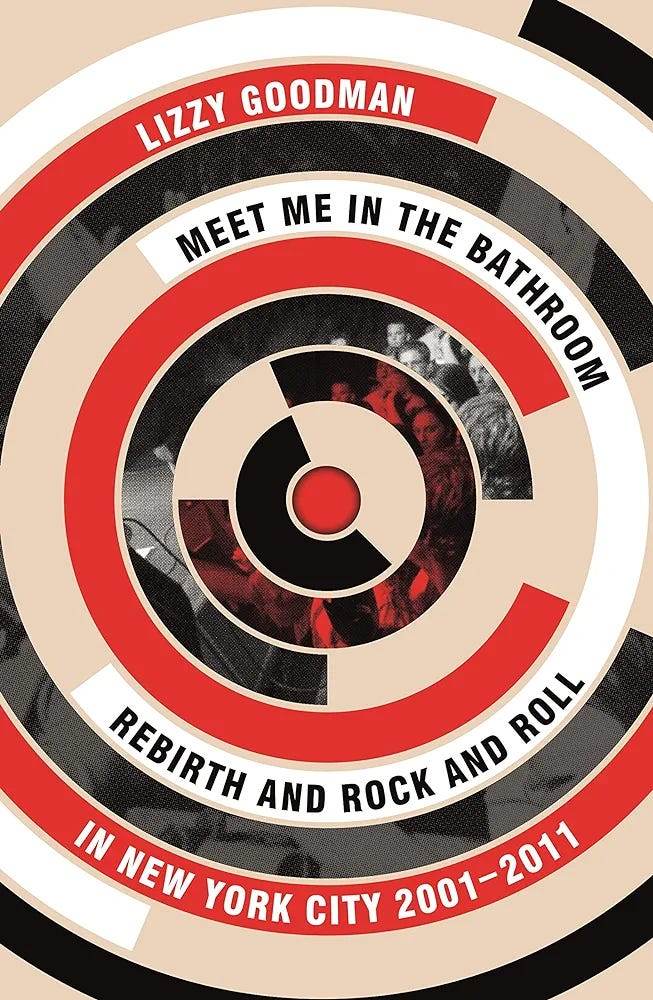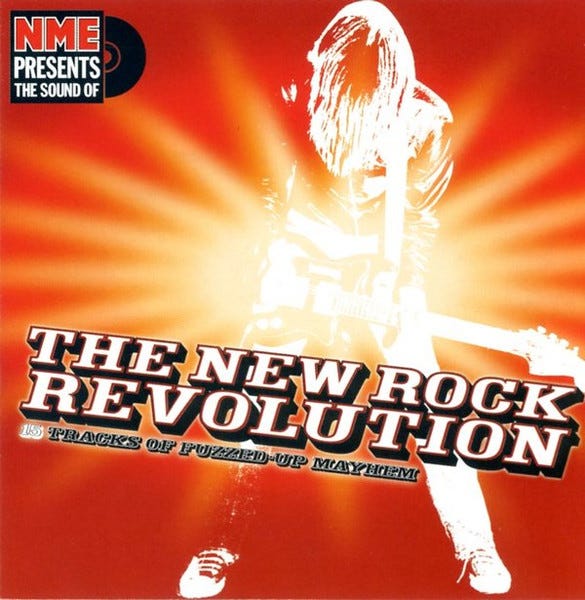Meet Me In The Bathroom - The Book That Inspired A Certain Romance
Just as The Strokes would prove to be the motivation for the bands that formed the New Yorkshire Wave, my manuscript was inspired by a book about the New Yorkers and the scene that evolved around them
In the spring of 2020, I was bored. Like millions across the globe, options for entertainment were limited during the numerous lockdowns of the COVID-19 pandemic. Libraries, bookshops, clubs, pubs, concert venues, schools and offices were all closed. So I did something I rarely do and that’s order some books online. C’mon now, a fair few of us ordered stuff online we didn’t necessarily need. It was one of few viable options to spend your hard-earned cash, furloughed or not.
Lord, how I missed my local library. I was a regular visitor and picked up books on a weekly basis. A keen reader since youth, I always had a book on the go that I’d dip into at lunchtime and before bed. That habit simply had to continue and the next book that I was due to reserve was Meet Me In The Bathroom: Rebirth and Rock and Roll in New York City 2001 - 2011 by Lizzy Goodman.
Similarities With A Certain Romance
It should not come as much of a surprise that there are so many similarities between my manuscript and Meet Me In The Bathroom. From the fact that both are oral histories, to the balanced cast, and inevitable crossover between them both. The stories feature somewhat inevitable resentment between bands in the music scenes, the compartmentalised locality of the bands involved, and reaches a sense of finality.
An Oral History
The most obvious similarities with Meet Me In The Bathroom centre on the subject matter and its delivery in print. Vivid oral histories seem to be the ideal way to divulge how a music scene came to happen. You need testimony from those who were there from the very start but also a touch of ranting, gossip, and the occasional musing to deliver anything like an accurate depiction of what went down.
While many fans would have seen the bands at the time, ideally an oral history wants to offer an AAA press. That means speaking to the people that were there and coaxing out their views. Once added to a logical narrative, these opinions and anecdotes form a tapestry of threads to form ‘the big picture’. There’s also Please Kill Me: The Uncensored Oral History of Punk by Legs McNeil and Gillian McCain if you want to read something similar.
Inevitable Resentment
Certain elements prove nigh on impossible to ignore when it comes to depicting a music scene. With every band clamouring for their spot in the limelight, there is inevitable resentment from aspiring musicians in the same city and beyond. Each band wants a bigger part of the pie but there’s only so much to go around.
Part of that resentment is orchestrated by the record companies and the press as band feuding finds its way into gossip columns and helps sell records. There are always regrets of bad behaviour, typically coaxed by a demand to be seen and read about. One I featured included Jon McClure (Reverend and The Makers) apologising to Jon Windle (Little Man Tate) for participating in the baiting that came from NME Magazine. Neither band were fully into it but felt almost obliged to co-operate when pushed by journalists.
Balanced Cast
The cast of characters (something I’ve featured before in this Substack) is also pretty closely balanced, like mine. Goodman was keen to ensure that the bands were well-represented, as well as club promoters, DJs, and journalists. Every character is a willing participant and many would be aware that they’ve been spoken about by someone else. That’s part of the thrill about getting juicy quotes as you know they can stir up some real excitement when put alongside someone else’s.
At several points in the book, I have Rick Martin defending NME’s tactics alongside those of band members who really didn’t want to play along. Whether that be the naming of a regional music scene, the ‘build them up to knock them down’ mantra, or how cruel some of the reviews were. It’s great to be able to present both sides of the story.
Granted, I steered away from gaining an audience with music execs and record label bosses but I did try to secure interviews. Also, considering that Goodman’s book is at a 160,000 word count, I’m not convinced I need to add to my 180,000 words. Goodman also spent around six years creating her manuscript, though she did carry out over 200 interviews and I stuck to around 50.
Crossover
There’s crossover, as you would expect. Certain bands became so noteworthy because they went beyond their local scene to international acclaim. The New Rock Revolution features heavily and you will find The Hives, The Vines, and The Libertines mentioned in Meet Me In The Bathroom as well as my manuscript. Thankfully, Goodman ensures that you have an idea of how those bands made their meteoric rises, from cold, damp rehearsal spaces all the way to worldwide tours. Dreams are realised and collateral damage follows.
Compartmentalised Locality
Goodman also looks at scenes within scenes, largely due to locality. I look at the S35 postcode in Sheffield that was home to Arctic Monkeys, Milburn, and Harrisons. You can liken those frontrunners with the noteworthy bands from Manhattan that featured in Meet Me In The Bathroom. The comparison is most easily made between Arctic Monkeys and The Strokes as the bands that brought their respective city’s music scenes to the spotlight.
It can prove difficult to compartmentalise bands like this and Goodman struggles when she tries to group bands from Brooklyn as ‘uncool’ kids, on geography alone. Thankfully, I had the Thee SPC record label to group a set of more acoustic-led bands which had more to do with the record label’s taste than my grouping but it did prove useful. That many of the Thee SPC bands came to the city for university and stayed is another simple way to compartmentalise them.
Sticking The Landing
One thing I do realise, having (hopefully) finished the manuscript is how hard it is to stick the landing. Goodman closes her book with the ‘final’ LCD Soundsystem gig at Madison Square Garden in 2011 which seems like a fair point to jump off. That is until you realise that there’s a big leap from the scene reaching its zenith in 2004 to the final 100 pages, especially if they cover seven years. When music scenes are petering out, there’s far less to write about compared to the excitement of them starting. Hopefully, Part Five of my book looks to be more consistent with the rest of the manuscript.
Emotional Journey
Like Goodman, I tried to base my manuscript on emotion and the journey rather than write about the music itself (I left that to reviewers for reasons of objectivity). There’s a sense that Meet Me In The Bathroom and my manuscript look at, and try to immerse readers in, a specific moment in time rather than drench it in years-old hyperbole. I certainly found it easier to base my manuscript on the testimony of others rather than try to sensationalise it with my own thoughts and opinions.
Time Period
Both my manuscript and Meet Me In The Bathroom are fixed in a certain period of time in certain locations. Of course, New York around 9/11 is going to be far more traumatic and propulsive than whatever happened in Sheffield and Leeds a couple of years later. Then again, there are similarities to the two settings at around the same time. All three cities would have to deal with gentrification and their music scenes would grapple with changing technology (file-sharing, CD burning, internet forums) and tastes.
Differences With A Certain Romance
Inevitably, there are several differences between Meet Me In The Bathroom and my manuscript. Lizzy Goodman put her credentials to great use to gain access, plus there was more of a sense of competition in the New York scene compared to the New Yorkshire Wave.
Credentials
What quickly becomes apparent when reading Goodman’s book is how well she used her credentials. I could barely call myself a journalist back then, I merely went to a few gigs and reviewed them for the local newspaper. My ear was not so much on the ground, though my eyes were affixed to internet forums which may have been a better way in at the time. Goodman had far more access which she worked hard on, she already had contacts in the press and band management and you can see them both being used. She may have even interviewed them before working out which quotes to use in her book. Goodman was also friends with the guitarist, Nick Valensi, before The Strokes became famous. A deep connection I cannot boast though I can count many of the players in the local Sheffield and Leeds scenes as friends.
Enhanced Competition
You could try and liken the impact of The Strokes to that of Arctic Monkeys. Both emerged from their local scene to critical, international acclaim. However, Goodman got to deal with the demise of the New Yorkers as the band struggled with being the frontrunners of a music scene and the expectations that came with it. While Arctic Monkeys continued to lead the way, The Strokes were partly submerged by the likes of Yeah Yeah Yeahs, Interpol, LCD Soundsystem, and The White Stripes. Put bluntly, The Strokes had a lot more competition, even more so when their second album, Room on Fire, largely disappointed.
You could argue that Goodman’s story is more compelling. Certainly, witnessing The Strokes succumb to a concoction of drugs, partying and infighting seems a touch more glamourous than the continually upwards trajectory of Arctic Monkeys. Then again, seeing how other bands in the same music scene deal with the shadow cast by Arctic Monkeys is a compelling story in its own right.
Of course, the key difference is that Goodman’s book is a publishing success whereas my manuscript remains a pdf file. Hopefully, my manuscript can emulate Goodman’s triumph.
Both Meet Me In The Bathroom and my manuscript are oral histories, even though Goodman’s is 99% quotes and mine is likely about half. They can both be considered as methods of preserving those memories from the time based on personal opinions. I tried really hard to grasp a sense of what was happening and preserve it for future generations, much like Goodman has. Whether it’s coherent and monumental or not is up to a publisher. I’d be pleased if someone was to independently draw comparisons between my manuscript and Meet Me In The Bathroom. That’s one of the reasons why art exists, to inspire others.







That’s another book that you’ve sold to me!